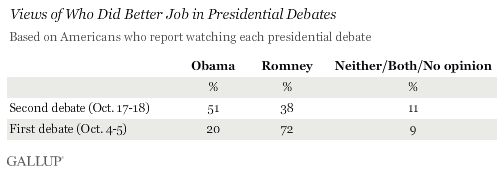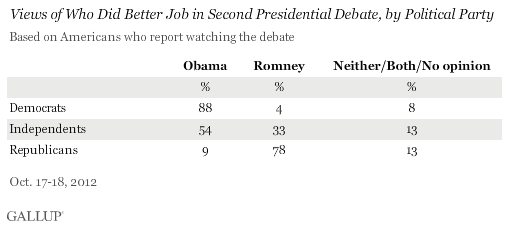PRINCETON, NJ -- Americans who report watching the second presidential debate between Barack Obama and Mitt Romney believe Obama did a better job, by 51% to 38%. That is a sharp reversal from the first debate for which Romney was widely regarded as the winner.

The second presidential debate took place in Hempstead, N.Y., on Oct. 16, with a group of uncommitted voters from the local area posing questions to the two candidates.
Three-fourths of Americans (76%) in an Oct. 17-18 Gallup poll say they watched the debate, higher than the 66% who told Gallup in an Oct. 4-5 poll that they watched the first presidential debate on Oct. 3.
The two-day field period after the night of the debate means Americans' judgments about who won not only reflect their personal reaction but may also be influenced by news coverage and media commentary in the days following the debate. However, most of the instant reaction polls conducted in the first few hours after the second debate also found debate watchers naming Obama the winner.
View of Debate Winner Largely in Eye of Beholder
Romney's victory in the first debate was so decisive that even a plurality of Democrats regarded him as the winner. That changed for the second debate, with Democrats overwhelmingly regarding Obama as the winner, 88% to 4%. Republicans show a similar propensity to favor their own party's nominee, naming Romney the winner, although by a slightly smaller margin, 78% to 9%. Independents give the edge to Obama, 54% to 33%.

Implications
Obama's performance in the second presidential debate was surely stronger than in the first, given that those who saw the debate regard Obama as the winner after debate watchers named Romney the landslide winner of the first debate.
It is too early to tell what impact the second debate will have on voters. Its impact may also be difficult to assess given that the third debate is taking place just six days after the second.
Historically, debates typically do not change voting preferences to a great degree. Even after Romney's strong performance in the first debate, his standing in Gallup Daily election tracking improved only slightly in the first several days of interviewing following the debate.
Nevertheless, Monday's final presidential debate is the last major scheduled event in the 2012 election campaign, so the status of the race after it takes place will give a strong indication of what the outcome of the election might be.
Survey Methods
Results for this Gallup poll are based on telephone interviews conducted Oct. 17-18, 2012, on the Gallup Daily election tracking survey, with a random sample of 1,007 adults, aged 18 and older, living in all 50 U.S. states and the District of Columbia.
For results based on the total sample of national adults, one can say with 95% confidence that the maximum margin of sampling error is ±4 percentage points.
For results based on the total sample of 813 Americans who say they watched the Oct. 16 presidential debate, one can say with 95% confidence that the maximum margin of sampling error is ±4 percentage points.
Interviews are conducted with respondents on landline telephones and cellular phones, with interviews conducted in Spanish for respondents who are primarily Spanish-speaking. Each sample includes a minimum quota of 250 cell phone respondents and 250 landline respondents per 500 national adults, with additional minimum quotas among landline respondents by region. Landline telephone numbers are chosen at random among listed telephone numbers. Cell phone numbers are selected using random-digit-dial methods. Landline respondents are chosen at random within each household on the basis of which member had the most recent birthday.
Samples are weighted by gender, age, race, Hispanic ethnicity, education, region, adults in the household, population density, and phone status (cell phone only/landline only/both, cell phone mostly, and having an unlisted landline number). Demographic weighting targets are based on the March 2011 Current Population Survey figures for the aged 18 and older non-institutionalized population living in the U.S. All reported margins of sampling error include the computed design effects for weighting.
In addition to sampling error, question wording and practical difficulties in conducting surveys can introduce error or bias into the findings of public opinion polls.
View methodology, full question results, and trend data.
For more details on Gallup's polling methodology, visit https://www.gallup.com/.
